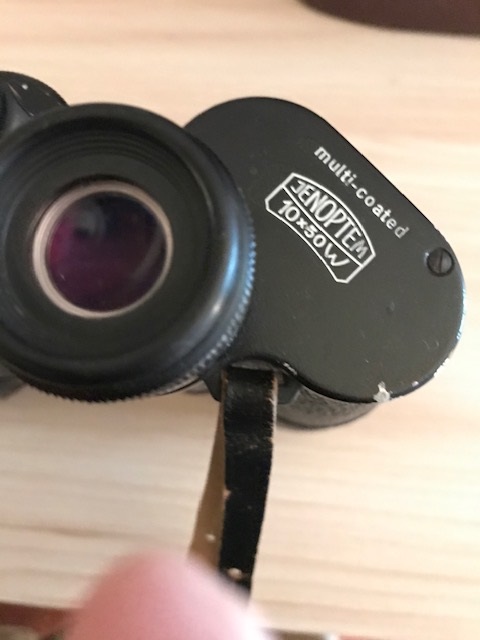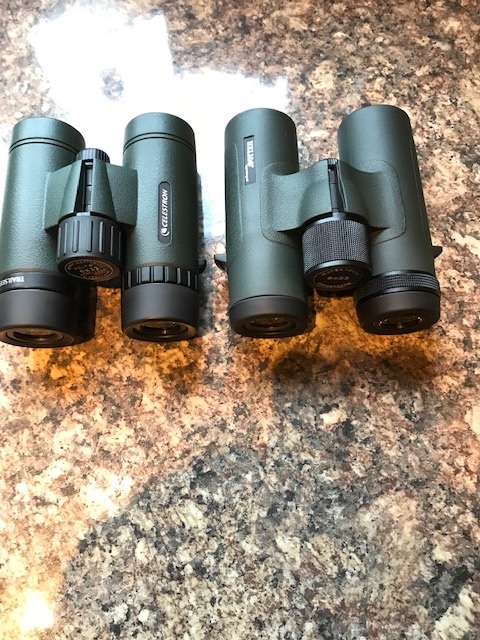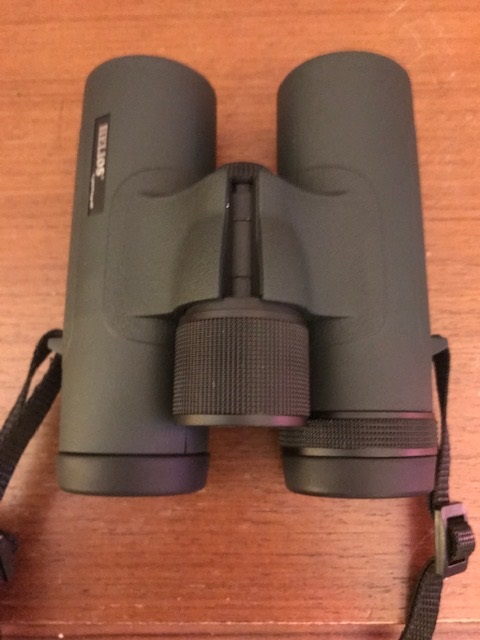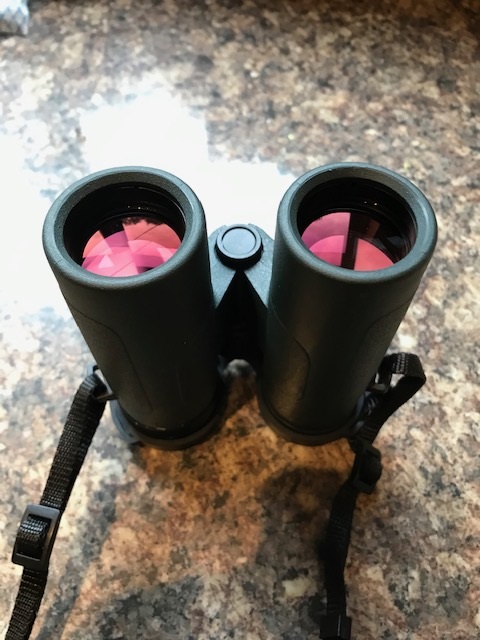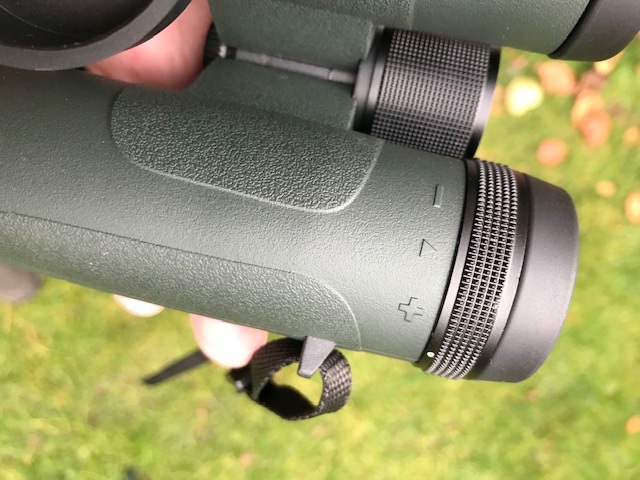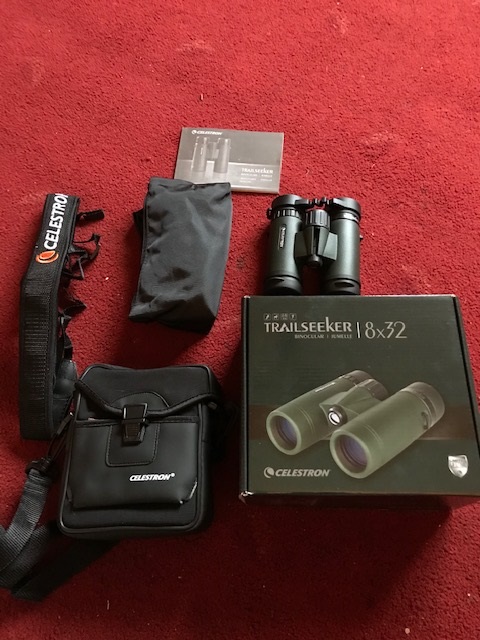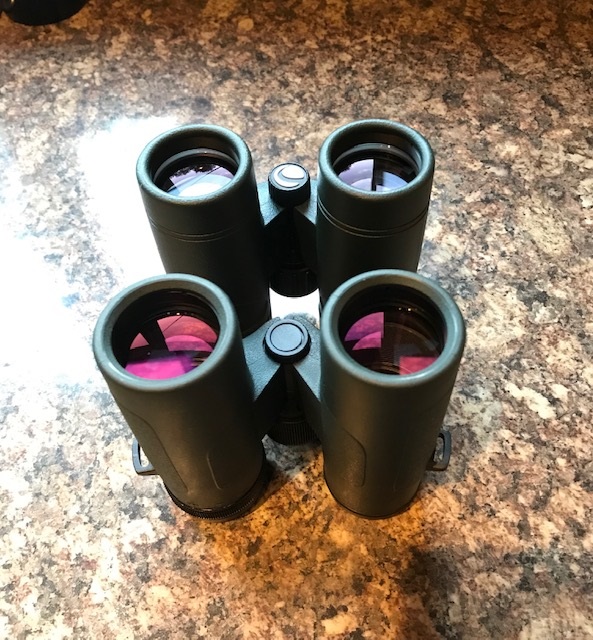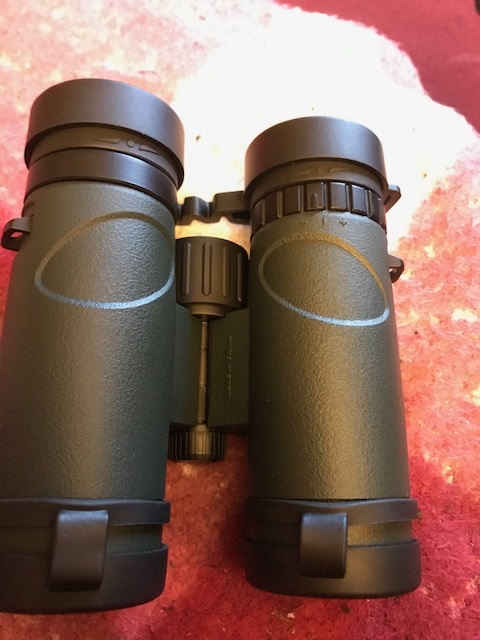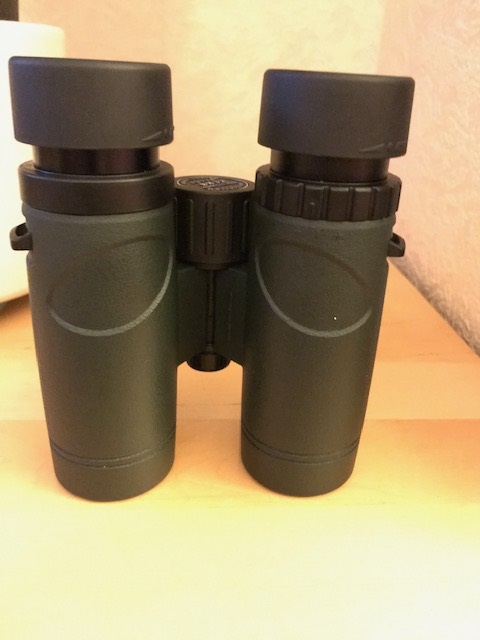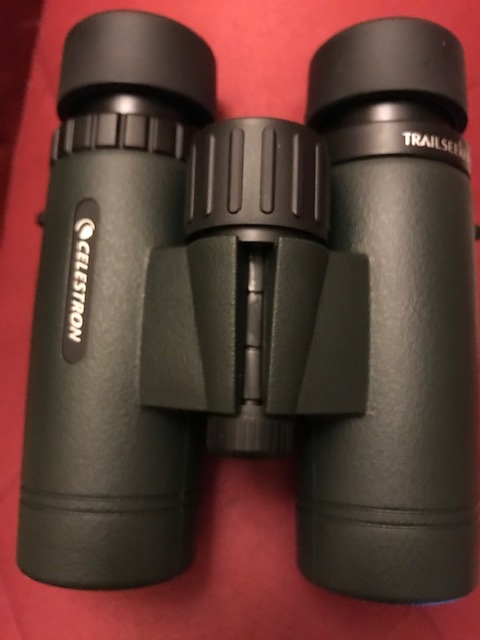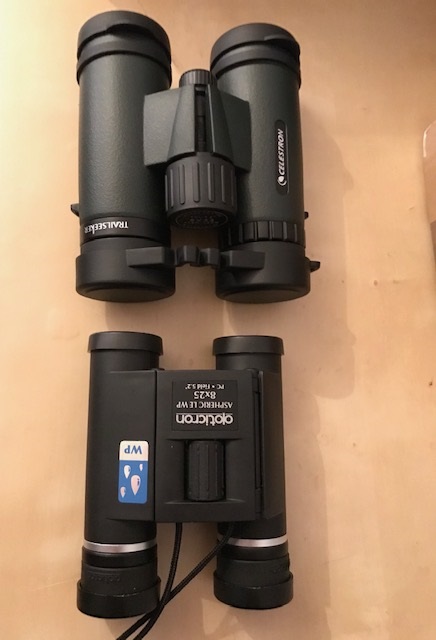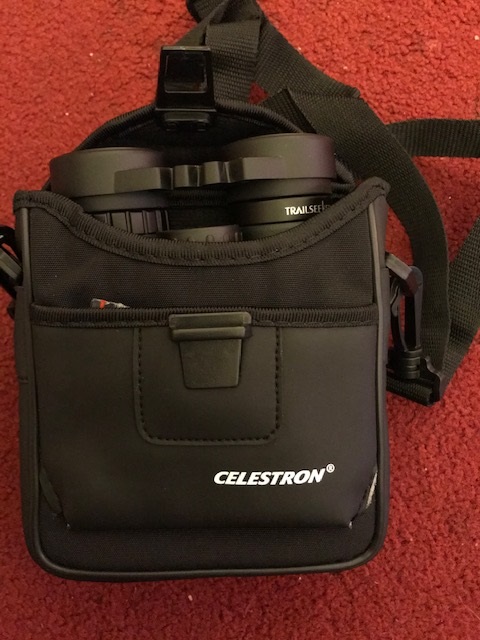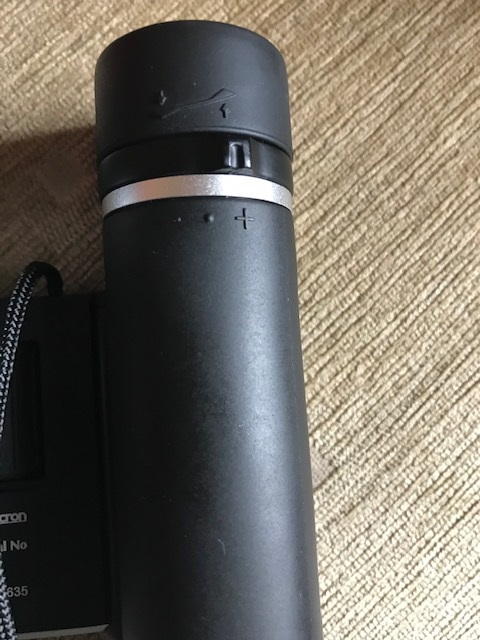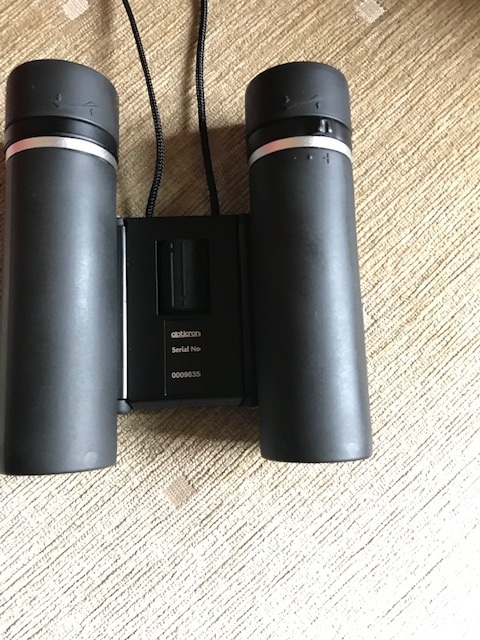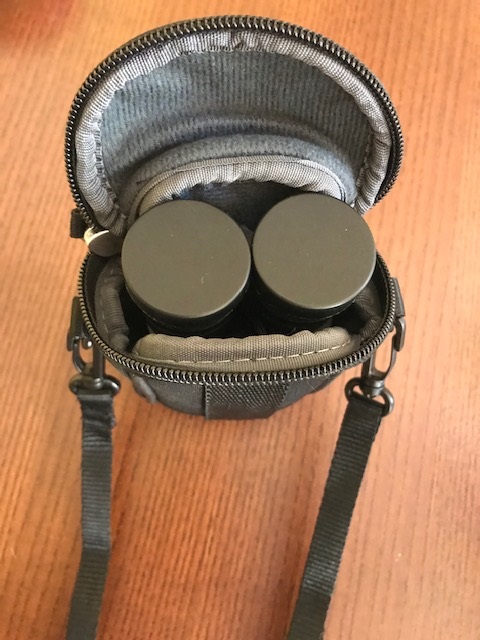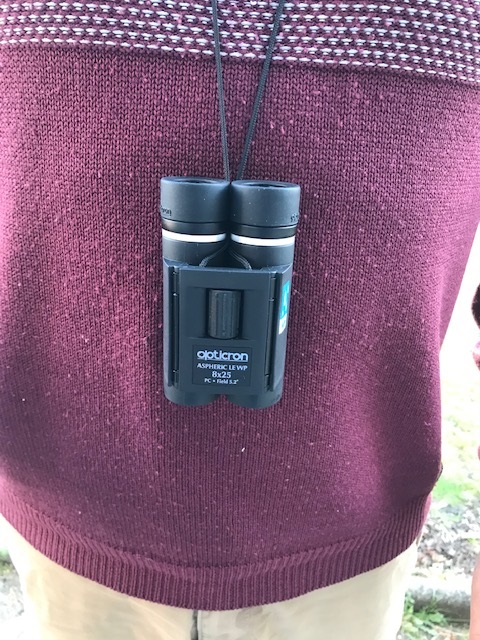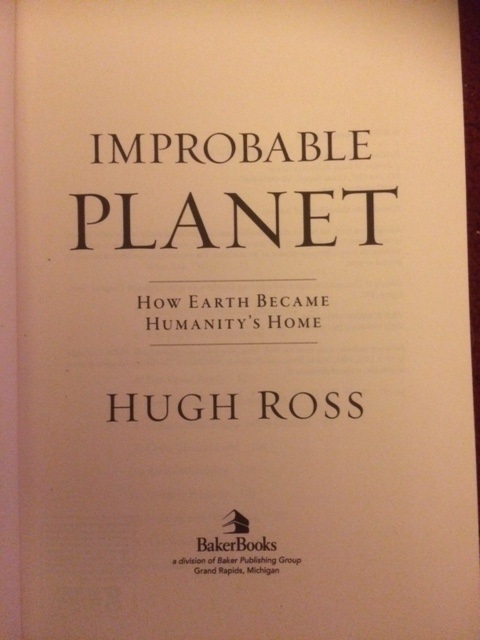
To establish ‘Limes.’
Back in the summer of 2019, I got the opportunity to test out a very high quality Swarovski EL Range 10 x 42 owned by a fellow villager named Ian. A keen hunter, he uses this binocular to seek out red deer and estimate their distance using the built-in laser telemetry in the instrument. A few weeks ago, I bumped into Ian in the swing park near my home, where he was looking after his young grandaughter, and we struck up another conversation about binoculars. I was returning from one of my walks, carrying along my little Zeiss Terra 8 x 25 pocket. He was fascinated with this new instrument, being duly impressed with its razor sharp optics, generous wide field, light-weight ergonomics and decent market value. It was then that I discovered that Ian was also the proud owner of a little Leica Trinovid BCA 8 x 20, which he purchased about two years back for casual sightseeing during his summer vacations in the Scottish northwest. Keen to expand my portfoIio of tested instruments, I asked him if he would be kind enough to let me borrow it for a wee while to evaluate its optical and mechanical performance. He agreed, but did say that he found the Terra to be very comfortable to use and was even considering acquiring one in the future! Fast forward a couple of weeks and Ian dropped by the Leica binocular at my home so that I could begin some tests, the results of which, I will divulge in this blog.
Leica is a German optical firm that has established itself as a world-leading manufacturer of high-end cameras, microscopes, camera lenses, binoculars and spotting ‘scopes for the burgeoning sports optics market. Founded in 1869 by Ernst Leitz, at Wetzlar, Germany, where the original factory remained until 1986, after which time production was moved to the town of Solms to the west of Wetzlar. In 1973, Leitz set up another large factory in Portugal, where it has remained to this day. With 1800 employees, Leica has an annual turnover of the order of 400 million Euro, and continues to produce state-of-the art optical equipment for private and public institutions(mostly universities and hospitals) the world over.
The Leica Trinovid line of binoculars has a long history. Leica first began to manufacture high-quality binoculars back in 1907, but the Trinovid line first appeared in 1953. Over the years, Leica has continued to develop their Trinovids, adding new optical technologies to their products where, today, they utilize some of the best glass and optical coatings available.
First Impressions
The quality of the device was immediately apparent to me as I prized the 8 x 20 from its somehwat oversized, soft carry case. Weighing in at just 235g, the Leica Trinovid BCA 8 x 20 measures just 9cm long, 6cm wide and 3.5cm deep when folded up. This makes it one of the smallest and most portable binoculars in continuous production today.
The binocular has a very traditional dual-hinge system but maintains a very classic look and feel, with an aluminium frame. Unlike their larger binoculars, the BCAs are described as ‘splashproof’, meaning that they will work fine in rainy conditions but are not hermetically sealed or dry nitrogen purged like the majority of roof prism binoculars today. The all-metal chassis is overlaid by a tough rubber armouring, which greatly improves its grip during field use and affords greater protection against accidental bumping or knocking about.
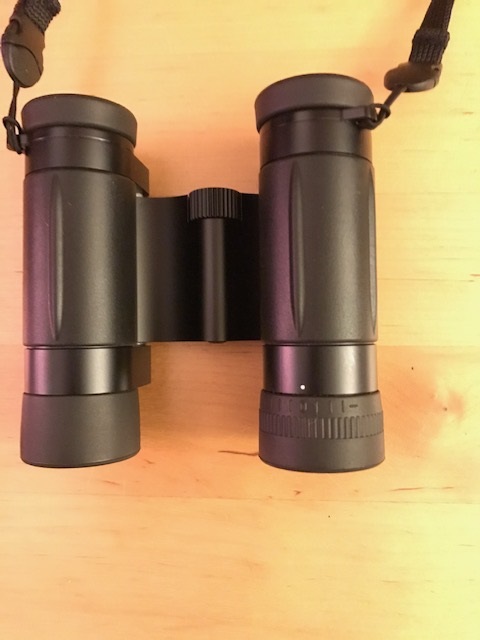
The strong and durable rubber armouring overlaying the aluminium chassis of the Leica Trinovid BCA 8 x 20.
The eyepieces are of exceptionally high quality, being made of metal overlaid by soft rubber cushions for comfortable viewing. They offer just two positions; fuly extended upwards for non-eyeglass wearers(including yours truly) or fully retracted when used with glasses. Eye relief is pretty tight though, at just 14mm, so some eyeglass wearers may struggle seeing the full field. The eyecups hold their position very well and can only be retracted by using considerable downward force. I must say that these are the finest eyepieces I have thus far experienced in my survey of the binocular market. Simply put, they are beautifully designed.
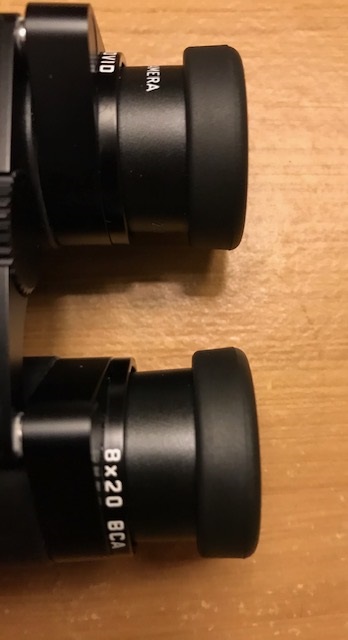
The beautifully designed eyepieces click rigidly into place.
Intriguingly, the dioptre setting(+/-3.5) is located on the right objective lens, which turns either clockwise or anti-clockwise. The focus wheel, which appears to be constructed of a hard plastic, is quite small but moves very smoothly with zero backlash. At first, it’s a bit fiddly to use but with a little practice becomes easier to negotiate, though it may present problems to those who wear gloves. All in all, the binocular is a study in elegant design. Clearly it was created not only to look good but to feel good in active service.
The Trinovid BCA has a high-quality, somewhat elastic, neckstrap, which is affixed via clips, so can be disengaged from the binocular if so desired. It is comfortable to use. Yet again, an unusual but very nice touch.
The objective lenses are not very deeply recessed in this model, perhaps because its designers aimed to minimise the length of the instrument. Having more deeply recessed objectives serves a number of useful purposes though, including protection against rain and dust, and serving well as an effective barrier against peripheral glare.
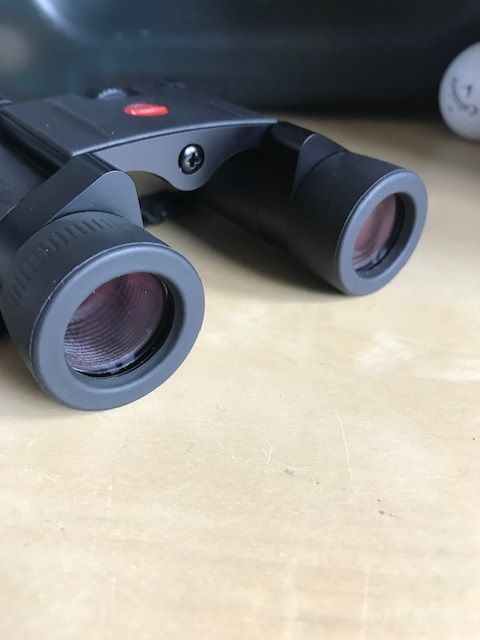
The objective lenses on the Trinovid are not very deeply recessed.
Optical Testing
As is customary for me with the arrival of any new binocular for testing, I began by assessing its performance in suppressing stray artificial light, internal reflections and glare. This is easily done by sharply focusing on a bright internal light source – I use my iphone torch at its brightest setting – in a darkened room and sharply focus on the light. Such tests quickly revealed highly satisfactory results. Stray light was very well controlled and very clean, with only very minor internal reflections and no sign of diffused glare often encountered in lesser models. The main artefact was a reasonably pronounced diffraction spike. Indeed, using two small ‘control’ binoculars; my Zeiss Terra 8 x 25 pocket and my recently acquired Celestron Trailseeker 8 x 32 (both of which exhibit excellent performance in this regard), I judged the Leica 8 x 20 to be as good, if not a little better, than my controls. All of these binoculars employ full, broadband multi-coated optics on all glass surfaces, with prisms that are dielectrically coated for highly efficient light transmission. The results predict that the Leica will perform excellently when pointed at strongly backlit daylight scenes, bright street lights and bright terrestrial targets like the Moon. There is no such thing as absolute perfection though. Such a complex optical device will always betray some degree of imperfection under these very stringent tests. I guess, it just comes with the territory!

The high quality HDC coating makes for exceptional light transmission.
In good accord with my flashlight tests, pointing the little Trinovid at a bright sodium street light at night showed no internal reflections, glare and only a very faint diffraction spike that I didn’t find intrusive. These tests were followed up by daylight optical assessments. Looking at tree trunks and branches during bright afternoon conditions showed that this 8 x 20 has excellent optics with a good, wide field of view. The image is tack sharp with a very large sweet spot. There is only slight softening of the images in the outer 10 per cent of the field. Colours are true to form and I detected only the merest trace of chromatic aberration and then only by looking very hard for it(I honestly find this activity rather pointless) on difficult targets. Contrast is exceptional with excellent control of stray light, as judged by imaging targets nearby a setting Sun under hazy sky conditions. There is a normal level of veiling glare which can be removed by blocking the Sun with an outstretched hand. There is also some minor pincushion distortion at the edge of the field but I still judged this to be well above average.
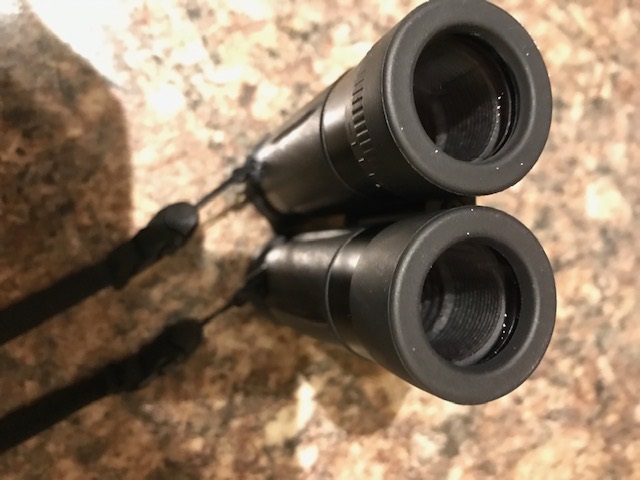
Excellent coatings make the objectives almost disappear.
Some readers will be surprised to learn that Leica did not employ any ED elements in the objective lenses of their BCA binoculars, proving once again that such an addition is not at all necessary to create an excellent optic(the Swarovski CL pocket and larger sibling, the CL 8 x 30 Companion are yet other examples). What really matters are well figured glass elements with high-quality anti-reflection coatings. Looking up its specifications online showed that Leica has spared no expense applying their famous(patented) High Durable Coating (HDC). It purports to be abrasion-resistant with enhanced light transmission, and then there’s the solid P40 dielectric phase coating applied to the Schmidt-Pechan roof prisms. What results is a highly efficient light gathering optic; an especially important commodity for tiny binoculars like these.
The Trinovid certainly delivers optically when the light is good and strong. But it does have some issues which are important to address. Because of its very small size, it’s actually quite challenging to hold steady during field use. It’s small exit pupil (2.5mm) also makes it considerably more difficult to position one’s eyes correctly compared with slightly larger binoculars, such as a good 8 x 25( with a 3.125mm exit pupil). Comparing its ergonomics with my Zeiss Terra 8 x 25 pocket glass showed that the Terra was simply much easier to engage with even though it’s only about 30 per cent heavier(310g). It’s larger frame also gives it the edge in terms of acheiving a good, stable image. This could prove important if the owner intends to use the 8 x 20 BCA for prolonged glassing periods, as the extra effort incurred in accurately positioning one’s eyes over the small exit pupils may induce eye strain with some users, so I think it’s important that people seriously considering this tiny glass try the more popular 8 x 25 units out before making that all-important purchase. Indeed, I believe this point was not lost on Ian when he tried the Terra out in the swing park that afternoon.
In an ongoing blog on using my 8 x 25 binos, I gave mention to why I think good pocket binoculars are quite expensive in the scheme of things. I attributed this to the extra difficulty in accurately positioning the many optical components stably within a scaled-down structure. The Leica Trinovid BCA 8 x 20 seems to follow this rule of thumb. It is smaller than any 8 x 25 model but is also more expensive(about £350 to £400 UK as opposed to £270 for the Zeiss Terra 8 x 25, for example). But there is surely folly in pursuing this to its logical conclusion. For example, would it be sensible to create an even smaller, state-of-the-art 15mm model say, that can fit on two fingers and cost £500?
Of course not! That would be daft. It would be too small and fiddly to use and the amount of light it would bring to one’s eyes- even if it were 100 per cent efficient – would severely limit its use. That’s probably why the other premium binocular manufacturers – particularly Zeiss and Swarovski – have discontinued their 8 x 20 models in favour of 8x and 10 x 25mm units. Indeed, all of this has close parallels to the premium, small refractor market, where folk seem to pay exorbitant prices for tiny, albeit perfect, optics. Is that really sensible? Not in my mind – which is why I turned my back on it- but your mileage may vary!
Assorted notes:
The Leica Trinovid BCA 8 x 20 has ocular lenses just a little smaller than its objective lenses.
The instrument comes with a ten year warranty.
Each Leica binocular comes with a test certificate which claims that it was examined at various times during its manufacture prior to leaving the factory.
The Leica mini-binocular didn’t appear to come with caps, either for the objectives or eyepieces. It does just fit the small Opticron branded rainguard for compact binos however, which I use with my 8 x 25s.
It’s hard to find the ‘made in Portugal’ stamp on the Leica. But it is there, stealthily placed under the left barrel of the optic, and only accessed by fully extending the instrument’s IPD to its maximum where you’ll see: Made by Leica Portugal in good light.
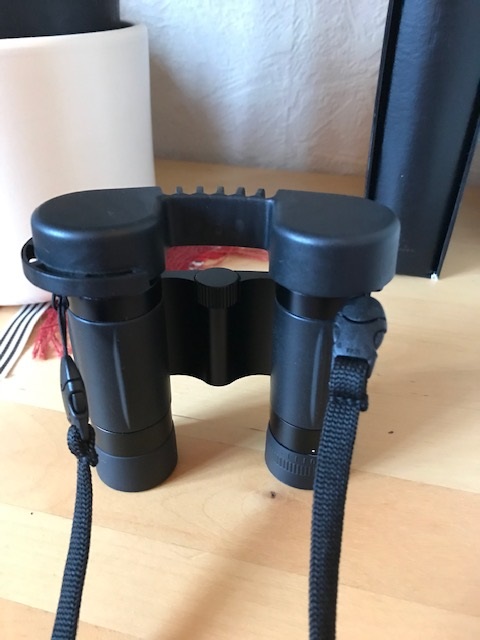
The Opticron-branded rainguard I use for my 8x 25s just fits the smaller leica binocular.
More info on this package here.
Comparison with other Premium Pocket Binoculars
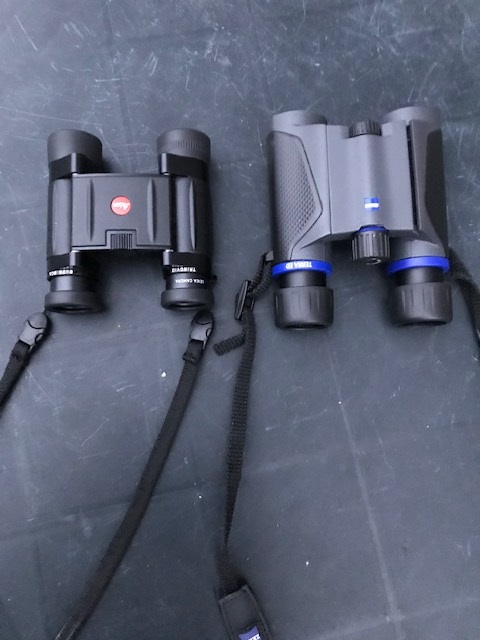
The Leica Trinovid BCA 8 x 20(left)versus with the Zeiss Terra 8 x 25(right). Note the latter’s larger frame and bigger focus wheel.
I spent a few hours comparing and contrasting the Zeiss Terra ED 8 x 25 and the Leica BCA 8 x 20 during bright sunny conditions(for January) and again under dull overcast conditions, as well as looking for performance differences at dusk, when the light rapidly fails afer sunset.
Under bright sunny conditions there was not much difference between both binoculars in terms of optical performance(both are excellent in this regard), except that the Zeiss has a noticeably wider field of view(119m compared with 110m@1000m). Because of its larger frame, larger focus wheel and larger exit pupil, the Zeiss proved easier to handle and easily rendered the more comfortable, immersive view. The weight difference between these instruments is only 75g, so I don’t think many folk would quibble about the increase in bulk mass.
Under dull overcast conditions, the Zeiss produced a slightly brighter image, which became more and more pronounced as the light began to fade after sunset(around 5pm local time in the last week in January). This ought not surprise anyone, as both binoculars are highly efficient light gatherers and so simple physics dictates that the larger 25mm glass wins.
Close focus on the Leica was estimated to be about 1.8 metres, significantly longer than the Zeiss Terra at 1.4 metres.
Comparison under the Stars
The differences between the 25mm glass and its 20mm counterpart was most pronounced when aimed at the night sky. The larger exit pupil and aperture on the Zeiss Terra pocket allowed me to see significantly fainter stars around Orion’s belt and in the Hyades, compared with the Leica. At first I judged the contrast to be slightly better in the Leica than in the Zeiss but upon reflection, I attribute this to the smaller exit pupil in the former, which naturally generates a darker sky hinterland. The wider field of view in the Zeiss also helps frame objects that little bit better than the Leica. So, for casual stargazing the Zeiss proved noticeably superior to the Leica 8 x 20. I would not really recommend the 8 x 20 for such activities over a larger glass. But neither should anyone expect miracles here. The Leica is designed for daylight use in the main, although one can always enjoy the odd look at the Moon with the 8 x 20 when it is present in the sky.
Comparisons to a Celestron Trailseeker 8 x 32 Compact Binocular

How does the Leica Trinovid BCA 8 x 20 compare with a good 8 x 32 compact binocular?
Comparing a mid-sized, semi-compact binocular like the Celestron Trailseeker 8 x 32 with a diminutive 8 x 20 might seem a little out of place. But I think its inclusion is valid. The Trailseeker is very light; indeed, at just 453g, it ranks as one of the lightest 8 x 32s on the market, but still has many mechanical and optical features that only a few years ago were the preserve of premium binoculars; a magnesium alloy chassis, solid, well-designed metal-under rubberised adjustable eyecups, fully broadband multicoatings, dielectrically coated Bak-4 prisms et cetera.
Comparing the images served up by both the Celestron and the Leica in bright daylight in the open air, my wife and I both concluded that the Leica has slightly better contrast and sharpness across much of the field than the Celestron 8 x 32. With a small exit pupil of 2.5mm, the best part of your eye lens images the field. Edge of field performance is also significantly better in the Leica. But we also agreed that the Celestron was more comfortable to use, owing to its larger exit pupil (4mm). That said, we also reached the conclusion that the Celestron binocular rendered a slightly brighter image even in good light. But while there are perceptible differences between the two instruments, it must be stressed that these differences are small and subtle. Of course, that conclusion will likely upset a few of the more pestiferous premium bino junkies out there, but it is nonetheless true in our experience. The Celestron held its own very well indeed against the sensibly perfect Leica.
But there is considerably more to say about the economical Trailseeker. Move from the open air into a heavily canopied forest or copse and the advantages of the larger aperture binocular become much more apparent. Under these conditions, the Celestron fairs a lot better, delivering brighter images and more information to the eye. And as the light diminishes in the late afternoon, the Celestron clearly pulls ahead, as it ought to do, owing to its much greater light gathering power. At dusk, the differences between the two models are literally like night and day. Under these conditions, the 8 x 32 Trailseeker is vastly superior. It doesn’t matter if the optics in the Leica are sensibly perfect when you can’t see those details.
You see, the little Leica is like an elastic band – stretch it too far and it will break!
The same was true when pointing both binoculars at the night sky. After struggling to peer through the Leica, the Celestron was pure joy! Its very efficient light transmission(~ 90 percent) and much wider field of view (7.8 degrees) brings so much more of the Universe to your eye!
These results helped us both to appreciate just how good the Chinese-made Celestron Trailseeker 8 x 32 really is. At roughly one third of the UK price(recently reduced to half its originanl market value(~£250) for clearance) of the Leica, we’d both say that it delivers 90 per cent of the bright, daytime performance of the Leica and vastly superior low light and night time performance. In many ways, this small and light-weight 8 x 32 is a more versatile performer than the 8 x 20 Leica Trinovid BCA, and those wishing to use their binoculars in more compromised lighting conditions would probably be better served with a good instrument in this size class.
And I have to ask this question again: is a weight of 453g really anathema to those who want to travel ultra-light?
nota bene: these comments regarding the Celestron Trailseeker 8 x 32 are also applicable to the previous discussion of my Zeiss Terra pocket glasss, in case you’re wondering.
These tests affirmed the excellent bang-for-buck the Celestron Trailseeker really represents. Veteran binocular enthusiast and fellow author, Gary Seronik, is dead right in highlighting these recent trends: mass produced, Chinese-derived optics are now coming so awfully close to premium performance-both optically and mechanically – that I would have reservations shelling out much more of my hard-earned cash just to get slightly better optical performance and the right to brag! For these reasons, I’m very pleased with and have no plans to upgrade the 8 x 32 Celestron; it will remain as part of my binocular stable.
Conclusions

The Leica Trinovid BCA 8 x 20: lean, mean optical machine.
The Leica Trinovid BCA 8 x 20 is a beautifully made pocket binocular that exudes elegance in both its solid mechanics and optics. It produces sensibly perfect images, rich in contrast and colour, whilst maintaining a very high degree of sharpness across the entire field. Perhaps uniquely, its advantages and disadvantages both pertain to its very small size. Provided one knows its limitations though, it ought to provide its owners with many years of service as a high-quality, ultra-portable optical system that can be used for casual glassing at sports events, mountain climbing, hiking, birding, general sight-seeing and even some limited astronomical viewing.
I found my time with the little Leica binocular to be a particularly enriching experience. While it is expensive, it is certainly money well spent, especially if you plan to use it on a regular basis. Yet again, I know why Ian chose this little optical marvel. During the very long days of a Scottish summer, when the light is good and strong, I can imagine him enjoying this super light binocular for hours on end.
Highly recommended!
The author would like to extend his thanks to Ian for lending him the Leica Trinovid BCA 8 x 20 for this review.
Explore More:
Ken Rockwell’s Review of the Leica Trinovid BCA 8 x 20
Best Binocular Review of the Leica Trinovid BCA 10 x 25
Neil English is the author of seven books in amateur and professional astronomy. His 8th title, Choosing & Using Binoculars: a Guide for Stargazers, Birders and Outdoor Enthusiasts, will be published in late 2023.


